
Variations of yellow
Encyclopedia
Displayed at right is the web color lemon chiffon
Lemon chiffon is a color that is reminiscent of the color of lemon
chiffon cake
.
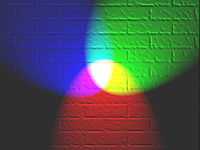 The color box at right shows the most intense yellow representable in 8-bit RGB color model
The color box at right shows the most intense yellow representable in 8-bit RGB color model
; yellow is a secondary color in an additive RGB space.
This color is also called color wheel yellow. It is at precisely 60 degrees on the HSV color wheel, also known as the RGB color wheel (Image of RGB color wheel:). Its complementary color
is blue
.
This color is called electric yellow when it is contrasted to the color process yellow, shown below.
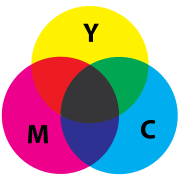 Process yellow (also called pigment yellow or printer's yellow), also known as canary yellow, is one of the three colors typically used as subtractive primary color
Process yellow (also called pigment yellow or printer's yellow), also known as canary yellow, is one of the three colors typically used as subtractive primary color
s, along with magenta
and cyan
.
Process yellow is not an RGB color, and in the CMYK color model
there is no fixed conversion from CMYK primaries to RGB. Different formulations are used for printer's ink, so there can be variations in the printed color that is pure yellow ink.
The first recorded use of canary yellow as a color name in English
was in 1789.
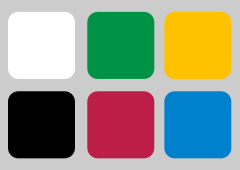 The color defined as yellow in the NCS or Natural Color System
The color defined as yellow in the NCS or Natural Color System
is shown at right (NCS 0580-Y). The Natural Color System is a color system based on the four unique hues
or psychological primary colors red, yellow, green, and blue. The NCS is based on the opponent process
theory of vision.
The “Natural Color System” is widely used in Scandinavia
.
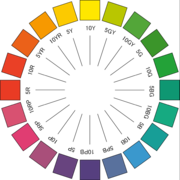 The color defined as yellow in the Munsell color system
The color defined as yellow in the Munsell color system
(Munsell 5Y) is shown at right. The Munsell color system is a color space
that specifies color
s based on three color dimensions: hue
, value (lightness
), and chroma (color purity), spaced uniformly in three dimensions in the elongated oval at an angle shaped Munsell color solid
according to the logarithmic scale
which governs human perception. In order for all the colors to be spaced uniformly, it was found necessary to use a color wheel with five primary colors--red, yellow, green, blue, and purple.
The Munsell colors displayed are only approximate as they have been adjusted to fit into the sRGB gamut.
 Lemon or lemon yellow is a color
Lemon or lemon yellow is a color
somewhat resembling yellow
and named after the fruit
. The color lemon is a representation of the color of the outer skin of a lemon.
The first recorded use of lemon as a color name in English
was in 1598.
 Gold, also called golden, is an orange-yellow
Gold, also called golden, is an orange-yellow
color
which is a representation of the color of the element
gold
.
The web color gold (also referred to as orange-yellow) is sometimes referred to as golden to distinguish it from the color metallic gold. The use of gold as a color term in traditional usage is more often applied to the color "metallic gold".
The first recorded use of golden as a color name in English
was in the year 1300 to refer to the element gold and in 1423 to refer to blonde hair.
This is the color called khaki in HTML/CSS.
The first recorded use of khaki as a color name in English
was in 1848.
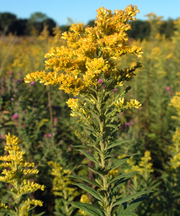
Displayed at right is the web color goldenrod.
The color goldenrod is a representation of the color of some of the deeper gold colored goldenrod
flower
s.
The first recorded use of goldenrod as a color name in English
was in 1915.
typically seen on green olives. It can be formed by adding a small amount of black
to yellow
dye or paint. As a color word in the English language
, it is unexpectedly old, appearing in late Middle English
. Shaded green, it becomes olive drab.
Olive can also be referred to as dark yellow. That the color olive is a shade of yellow can readily be ascertained by inspecting its hex code—the red and green values are equal, with no blue value, signifying a shade of yellow.
Lemon chiffon is a color that is reminiscent of the color of lemon
Lemon
The lemon is both a small evergreen tree native to Asia, and the tree's ellipsoidal yellow fruit. The fruit is used for culinary and non-culinary purposes throughout the world – primarily for its juice, though the pulp and rind are also used, mainly in cooking and baking...
chiffon cake
Chiffon cake
A chiffon cake is a very light cake made with vegetable oil, eggs, sugar, flour, baking powder, and flavorings. It is a combination of both batter and foam type cakes...
.
Yellow (RGB) (X11 yellow) (color wheel yellow) (electric yellow)

RGB color model
The RGB color model is an additive color model in which red, green, and blue light is added together in various ways to reproduce a broad array of colors...
; yellow is a secondary color in an additive RGB space.
This color is also called color wheel yellow. It is at precisely 60 degrees on the HSV color wheel, also known as the RGB color wheel (Image of RGB color wheel:). Its complementary color
Complementary color
Complementary colors are pairs of colors that are of “opposite” hue in some color model. The exact hue “complementary” to a given hue depends on the model in question, and perceptually uniform, additive, and subtractive color models, for example, have differing complements for any given color.-...
is blue
Blue
Blue is a colour, the perception of which is evoked by light having a spectrum dominated by energy with a wavelength of roughly 440–490 nm. It is considered one of the additive primary colours. On the HSV Colour Wheel, the complement of blue is yellow; that is, a colour corresponding to an equal...
.
This color is called electric yellow when it is contrasted to the color process yellow, shown below.
Yellow (CMYK) (process yellow) (canary yellow)

Primary color
Primary colors are sets of colors that can be combined to make a useful range of colors. For human applications, three primary colors are usually used, since human color vision is trichromatic....
s, along with magenta
Magenta
Magenta is a color evoked by light stronger in blue and red wavelengths than in yellowish-green wavelengths . In light experiments, magenta can be produced by removing the lime-green wavelengths from white light...
and cyan
Cyan
Cyan from , transliterated: kýanos, meaning "dark blue substance") may be used as the name of any of a number of colors in the blue/green range of the spectrum. In reference to the visible spectrum cyan is used to refer to the color obtained by mixing equal amounts of green and blue light or the...
.
Process yellow is not an RGB color, and in the CMYK color model
CMYK color model
The CMYK color model is a subtractive color model, used in color printing, and is also used to describe the printing process itself. CMYK refers to the four inks used in some color printing: cyan, magenta, yellow, and key...
there is no fixed conversion from CMYK primaries to RGB. Different formulations are used for printer's ink, so there can be variations in the printed color that is pure yellow ink.
The first recorded use of canary yellow as a color name in English
English language
English is a West Germanic language that arose in the Anglo-Saxon kingdoms of England and spread into what was to become south-east Scotland under the influence of the Anglian medieval kingdom of Northumbria...
was in 1789.
Yellow (NCS) (psychological primary yellow)

Natural Color System
The Natural Color System is a proprietary perceptual color model published by the Scandinavian Colour Institute of Stockholm, Sweden. It is based on the color opponency description of color vision, first proposed by German physiologist Ewald Hering...
is shown at right (NCS 0580-Y). The Natural Color System is a color system based on the four unique hues
Unique hues
In the opponent process theory of color, there are four unique hues – red, yellow, green, and blue – relative to which other hues are defined. Unique red is a red which appears to have no yellow or blue in it; unique yellow is a yellow which appears to have no red or green in it; etc.Color names...
or psychological primary colors red, yellow, green, and blue. The NCS is based on the opponent process
Opponent process
The color opponent process is a color theory that states that the human visual system interprets information about color by processing signals from cones and rods in an antagonistic manner...
theory of vision.
The “Natural Color System” is widely used in Scandinavia
Scandinavia
Scandinavia is a cultural, historical and ethno-linguistic region in northern Europe that includes the three kingdoms of Denmark, Norway and Sweden, characterized by their common ethno-cultural heritage and language. Modern Norway and Sweden proper are situated on the Scandinavian Peninsula,...
.
Yellow (Munsell)

Munsell color system
In colorimetry, the Munsell color system is a color space that specifies colors based on three color dimensions: hue, value , and chroma . It was created by Professor Albert H...
(Munsell 5Y) is shown at right. The Munsell color system is a color space
Color space
A color model is an abstract mathematical model describing the way colors can be represented as tuples of numbers, typically as three or four values or color components...
that specifies color
Color
Color or colour is the visual perceptual property corresponding in humans to the categories called red, green, blue and others. Color derives from the spectrum of light interacting in the eye with the spectral sensitivities of the light receptors...
s based on three color dimensions: hue
Hue
Hue is one of the main properties of a color, defined technically , as "the degree to which a stimulus can be describedas similar to or different from stimuli that are described as red, green, blue, and yellow,"...
, value (lightness
Lightness (color)
Lightness is a property of a color, or a dimension of a color space, that is defined in a way to reflect the subjective brightness perception of a color for humans along a lightness–darkness axis. A color's lightness also corresponds to its amplitude.Various color models have an explicit term for...
), and chroma (color purity), spaced uniformly in three dimensions in the elongated oval at an angle shaped Munsell color solid
Color solid
A color solid is the three-dimensional representation of a color model, an analog of the two-dimensional color wheel. The added spatial dimension allows a color solid to depict an added dimension of color variation...
according to the logarithmic scale
Logarithmic scale
A logarithmic scale is a scale of measurement using the logarithm of a physical quantity instead of the quantity itself.A simple example is a chart whose vertical axis increments are labeled 1, 10, 100, 1000, instead of 1, 2, 3, 4...
which governs human perception. In order for all the colors to be spaced uniformly, it was found necessary to use a color wheel with five primary colors--red, yellow, green, blue, and purple.
The Munsell colors displayed are only approximate as they have been adjusted to fit into the sRGB gamut.
Lemon yellow

Color
Color or colour is the visual perceptual property corresponding in humans to the categories called red, green, blue and others. Color derives from the spectrum of light interacting in the eye with the spectral sensitivities of the light receptors...
somewhat resembling yellow
Yellow
Yellow is the color evoked by light that stimulates both the L and M cone cells of the retina about equally, with no significant stimulation of the S cone cells. Light with a wavelength of 570–590 nm is yellow, as is light with a suitable mixture of red and green...
and named after the fruit
Lemon
The lemon is both a small evergreen tree native to Asia, and the tree's ellipsoidal yellow fruit. The fruit is used for culinary and non-culinary purposes throughout the world – primarily for its juice, though the pulp and rind are also used, mainly in cooking and baking...
. The color lemon is a representation of the color of the outer skin of a lemon.
The first recorded use of lemon as a color name in English
English language
English is a West Germanic language that arose in the Anglo-Saxon kingdoms of England and spread into what was to become south-east Scotland under the influence of the Anglian medieval kingdom of Northumbria...
was in 1598.
Gold (Golden)

Yellow
Yellow is the color evoked by light that stimulates both the L and M cone cells of the retina about equally, with no significant stimulation of the S cone cells. Light with a wavelength of 570–590 nm is yellow, as is light with a suitable mixture of red and green...
color
Color
Color or colour is the visual perceptual property corresponding in humans to the categories called red, green, blue and others. Color derives from the spectrum of light interacting in the eye with the spectral sensitivities of the light receptors...
which is a representation of the color of the element
Chemical element
A chemical element is a pure chemical substance consisting of one type of atom distinguished by its atomic number, which is the number of protons in its nucleus. Familiar examples of elements include carbon, oxygen, aluminum, iron, copper, gold, mercury, and lead.As of November 2011, 118 elements...
gold
Gold
Gold is a chemical element with the symbol Au and an atomic number of 79. Gold is a dense, soft, shiny, malleable and ductile metal. Pure gold has a bright yellow color and luster traditionally considered attractive, which it maintains without oxidizing in air or water. Chemically, gold is a...
.
The web color gold (also referred to as orange-yellow) is sometimes referred to as golden to distinguish it from the color metallic gold. The use of gold as a color term in traditional usage is more often applied to the color "metallic gold".
The first recorded use of golden as a color name in English
English language
English is a West Germanic language that arose in the Anglo-Saxon kingdoms of England and spread into what was to become south-east Scotland under the influence of the Anglian medieval kingdom of Northumbria...
was in the year 1300 to refer to the element gold and in 1423 to refer to blonde hair.
Khaki
Displayed at right is the HTML/CSS web color khaki.This is the color called khaki in HTML/CSS.
The first recorded use of khaki as a color name in English
English language
English is a West Germanic language that arose in the Anglo-Saxon kingdoms of England and spread into what was to become south-east Scotland under the influence of the Anglian medieval kingdom of Northumbria...
was in 1848.
Goldenrod

Displayed at right is the web color goldenrod.
The color goldenrod is a representation of the color of some of the deeper gold colored goldenrod
Goldenrod
Solidago, commonly called goldenrods, is a genus of about 100 species of flowering plants in the family Asteraceae. Most are herbaceous perennial species found in the meadows and pastures, along roads, ditches and waste areas in North America. There are also a few species native to Mexico, South...
flower
Flower
A flower, sometimes known as a bloom or blossom, is the reproductive structure found in flowering plants . The biological function of a flower is to effect reproduction, usually by providing a mechanism for the union of sperm with eggs...
s.
The first recorded use of goldenrod as a color name in English
English language
English is a West Germanic language that arose in the Anglo-Saxon kingdoms of England and spread into what was to become south-east Scotland under the influence of the Anglian medieval kingdom of Northumbria...
was in 1915.
Olive
The web color olive is a dark shade of yellowYellow
Yellow is the color evoked by light that stimulates both the L and M cone cells of the retina about equally, with no significant stimulation of the S cone cells. Light with a wavelength of 570–590 nm is yellow, as is light with a suitable mixture of red and green...
typically seen on green olives. It can be formed by adding a small amount of black
Black
Black is the color of objects that do not emit or reflect light in any part of the visible spectrum; they absorb all such frequencies of light...
to yellow
Yellow
Yellow is the color evoked by light that stimulates both the L and M cone cells of the retina about equally, with no significant stimulation of the S cone cells. Light with a wavelength of 570–590 nm is yellow, as is light with a suitable mixture of red and green...
dye or paint. As a color word in the English language
English language
English is a West Germanic language that arose in the Anglo-Saxon kingdoms of England and spread into what was to become south-east Scotland under the influence of the Anglian medieval kingdom of Northumbria...
, it is unexpectedly old, appearing in late Middle English
Middle English
Middle English is the stage in the history of the English language during the High and Late Middle Ages, or roughly during the four centuries between the late 11th and the late 15th century....
. Shaded green, it becomes olive drab.
Olive can also be referred to as dark yellow. That the color olive is a shade of yellow can readily be ascertained by inspecting its hex code—the red and green values are equal, with no blue value, signifying a shade of yellow.

